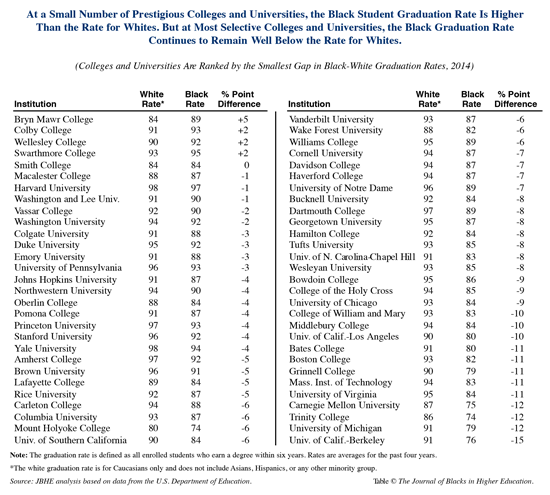 Here at JBHE, we have always been particularly interested in how Black students are succeeding at our nation’s highest-ranked colleges and universities. At these high-ranking colleges and universities, Black students generally do very well and in many cases have graduation rates that are very close to those of their White peers. At a few of the nation’s top-ranked schools, the Black graduation rate is actually higher than the rate for White students. It is very encouraging that the Black graduation rate has improved at many of the top-ranked schools and the racial gap in graduation rates has narrowed.
Here at JBHE, we have always been particularly interested in how Black students are succeeding at our nation’s highest-ranked colleges and universities. At these high-ranking colleges and universities, Black students generally do very well and in many cases have graduation rates that are very close to those of their White peers. At a few of the nation’s top-ranked schools, the Black graduation rate is actually higher than the rate for White students. It is very encouraging that the Black graduation rate has improved at many of the top-ranked schools and the racial gap in graduation rates has narrowed.

JBHE research has found 15 high-ranking colleges and universities that have Black student graduation rates that have averaged over 90 percent over the past four years. The highest rate is at Harvard University, where 97 percent of entering Black students earn their degree within six years at Harvard. At Swarthmore College in Pennsylvania, the Black student graduate rate is 95 percent. Blacks at Yale University graduate at a rate of 94 percent and Princeton University, Colby College, and the University of Pennsylvania have Black student graduation rates of 93 percent.
There are five high-ranking colleges where the Black student graduation rate is equal to or higher than the rate for White students. It is interesting that three of these five schools are women’s colleges: Wellesley, Bryn Mawr, and Smith.
Among the high-ranking national universities, Harvard has a Black graduation rates that is only one percentage point below the rate for Whites. At Washington University in St. Louis, the Black graduation rate is two percentage points below the rate for Whites. Duke, Emory, and the University of Pennsylvania have Black graduation rates that trail the White rate by only three percentage points.
A decade ago, only five of these top-ranked colleges and universities had Black graduation rates of 90 percent or more, compared to 15 today. That is impressive progress. In 2004, 15 of these high-ranking colleges and universities had racial graduation rate gaps of more than 12 percentage points. Today, there is only one.












